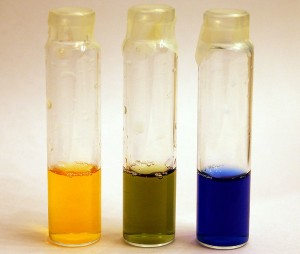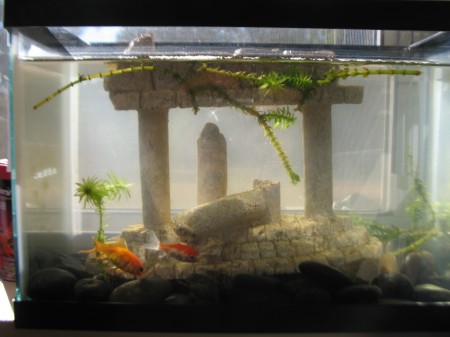While we were working on the needs of living things a couple weeks ago, we acquired two fish; goldfish, fifteen cents apiece.
It was supposed to only be a mental exercise. If you put a water plant, Egeria densa in this case, in an enclosed jar and left it in the sunlight, the plant should use the carbon dioxide in the water to produce oxygen during photosynthesis. A similar jar kept in the dark would produce carbon dioxide and use oxygen as the plant respired.

That was the practical part. Students measure the pH of the water before and after a day in the light and dark. The pH of the jar in the dark should go down as the added carbon dioxide makes the water slightly more acidic. Bromthymol blue solution in the water changes color very nicely within the pH range of this experiment, but, in a pinch, you can also use the pH color strips that are sold for testing aquarium water.
My students did the experiment, made their observations and came to conclusions. Then the lab activity asked them to think about what would happen if you put a fish into each of the jars, to see if students are able to extrapolate based on a well rounded knowledge of respiration and photosynthesis.
My students did the mental experiment, but the next day our two fish turned up, uninvited at least by me.
I’d anticipated something like this so I’d picked up a small fish tank at a yard sale over the summer. I’m not opposed to keeping animals in the classroom, as long as I don’t have to take care of them. Fortunately, since we’re studying life, keeping organisms and attending their needs is something the kids are learning and there is no better way to learn that via practice.
Our fish are surviving. The students have added some gravel and structures to provide habitat. The waterplants, still in there to provide oxygen, seem to be thriving despite some browsing by the goldfish.
One of the few rules is that anything added to the tank should have some purpose to help support the needs of the fish. I’m also encouraging the students to think of ways of maintaining conditions in the tank which would minimize their work. Hopefully some filter feeders, maybe small clams, and similar organisms will turn up and we can talk about ecology. I may have to nudge them in that direction though.
I’m not sure what the fish’s names are as there seems to be some controversy among the students. With a little luck they’ll survive until we start comparing religions. Two years ago we had a frog who passed away at just the right time for us to have to figure out what religion he/she was so we could perform last rites.
And no, I did not kill the frog.
